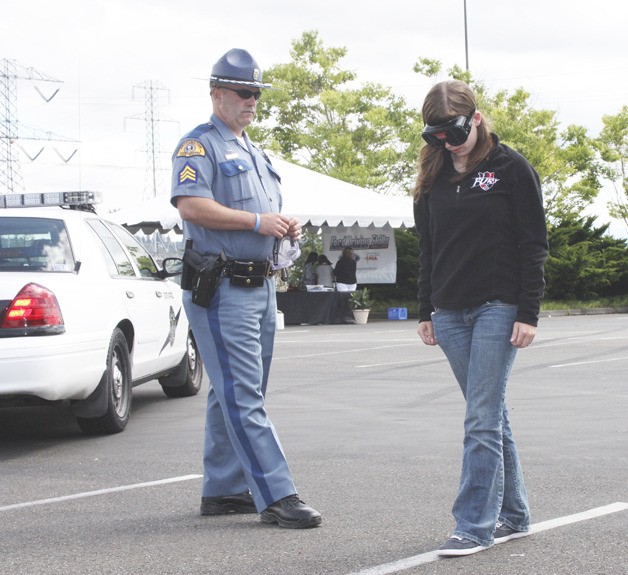It’s one thing to explain how a car handles in adverse situations and conditions.
It’s entirely another to actually grip the steering wheel and feel how the car handles as the rear end slides, the tires stop gripping the road or the brakes lock up.
For many drivers, this experience behind the wheel can make the difference between life and death. For new teen drivers, this is especially true.
Local teen drivers got a chance to put a little more driving experience under their belts, courtesy of the Ford Driving Skills for Life program, which took place last week at Emerald Downs.
Since 2003, the program has been traveling around the country seeking to educate new drivers on the hazards of operating an automobile and combat accidents and fatalities, which are the leading cause of death among teens, according to the National Highway Traffic Safety Association. In 2008, 3,500 teens were killed in traffic accidents, with drivers aged 16 to 19 averaging nine deaths a day. Teens were four-times more likely to be involved in a fatal accident than older drivers.
That’s why James Graham, spokesperson for the Ford Driving Skills Life program, has devoted his time to the program.
“It’s the best job I’ve ever had,” he said. “It’s saving lives.”
Graham explained that the program seeks to give teen drivers a little more experience, showing them things like how the car handles under adverse braking and cornering conditions, as well as how to deal with road hazards and distractions such as texting while driving.
“Drivers ed is not taught in schools now,” he said. “And they just teach them elementary things, basic rules of the road. We’re teaching advanced skills. So our target market is kids who have permits and have been driving a bit, and their parents.”
At Emerald Downs’ north parking lot, participants were accorded the chance to get behind the wheel of a Mustang and experience how the car handles, as they skidded and braked through a cone course. They also were given the opportunity to maneuver a car through a course, wearing impairment goggles that simulate the way intoxication can distort vision.
At the impairment station, one of four different stations at the event, Washington State Patrol Sgt. Ken Denton ran the kids through a field sobriety test. Participants were asked to balance on one foot with their other foot held out in front of them, then asked to walk heel to toe down a straight line painted on the ground. They were then asked to perform the same tasks with the goggles on.
“They’re very interesting,” Anna Fairchuk, 16, said. “It was hard to pay attention to where your foot was.”
After that the drivers traversed a cone course, first without the goggles and then with them.
“It was extremely difficult driving with them,” Fairchuk said. “I’m pretty sure I would have killed a couple people.”
“I think they learn from it,” Denton said. “And one of the things I think they learn from being behind the wheel here is how they don’t focus just right in front of them.”
Making better decisions
According to Graham, the impairment experience is just one part of the program that seeks to arm teen drivers with better decision making tools and the skills to actually get themselves out of trouble when behind the wheel.
“We really talk about decision making a lot, about don’t take the risk,” he said. “There are three things we talk about all the time. You need to concentrate, pay attention all the time, don’t get distracted. You need to know how the car feels. There are only four contact patches the car sits on, so what happens when you brake and the weight shifts. So we talk about that. And the other thing is where your eyes are. The car goes where you are looking.
“Our goal is that they take away one or two of these things,” he added. “They won’t remember everything. And we want them to tell their friends who couldn’t come out. It’s all about saving lives.”
That’s why Andy Fairchuk brought his daughter Anna out.
“She’s had a permit for a while,” he said. “She did the driving class at her high school, Bellarmine. My older daughter has already totaled a car twice. So we figured that if we can get her (Anna) some more experience before she hits the road, it’s better for her. I’m in the military, so it’s all about contingency planning.”
His daughter agreed:
“I’d like to be able to know what to do in an emergency situation and handle them,” she said. “I thought it was a good idea to come out here.”
According to Graham, reaction to the program is always positive.
“The reaction is excellent,” Graham said. “Parents usually ask when we’re coming back because they have other kids who are coming up. We do it right, we get the right instructors, we get the right cars. It’s a first-class program, so they want it back. If you’re the parent of a licensed teen, like I have been, you want all the resources you can get. And there aren’t many programs like this one around, especially ones that are free. So it’s overwhelmingly positive. We have not had one complaint ever, it’s usually, ‘We need more of this.’
“We believe in these programs. They work,” he added. “They just need to just keep practicing and not take chances. We talk a lot about the risks they take.”


